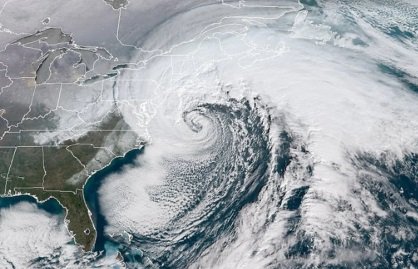An extreme weather event is approaching the U.S. West Coast, known as a bomb cyclone. This formidable storm system, fueled by a strong atmospheric river, is expected to unleash destructive conditions, including torrential rainfall, snowfall, and high winds, across several states.
Defining a Bomb Cyclone
A bomb cyclone is a powerful winter storm characterized by a rapid drop in atmospheric pressure. For a storm to qualify, the pressure must plummet by at least 24 millibars within 24 hours—a process known as explosive cyclogenesis. The approaching storm is predicted to drop an unprecedented 70 millibars in a single day, with pressure levels potentially reaching 942 millibars, akin to a Category 4 hurricane.
How Do Bomb Cyclones Form?
Bomb cyclones occur when warm, moist air from tropical regions collides with cold Arctic air. The interaction creates a rapid intensification of the storm. The term “bomb cyclone,” coined in the 1980s by meteorologists, compares the storm’s rapid intensification to the sudden release of energy in an explosion.
The Role of the Atmospheric River
This bomb cyclone is intensifying due to its merger with an atmospheric river—a narrow band of concentrated atmospheric moisture. Atmospheric rivers are responsible for delivering significant precipitation, including rain and snow. The fusion of the bomb cyclone and the atmospheric river amplifies the storm’s power, making it a particularly destructive event.
Rainfall Predictions and Regional Impact
The storm is expected to bring unprecedented rainfall to the western U.S.:
- California: Approximately 8 trillion gallons of water in a week.
- Oregon: Around 5 trillion gallons.
- Washington: Expected to receive 3 trillion gallons.
- Idaho: Could see about 2.5 trillion gallons.
In total, nearly 20 trillion gallons of water may inundate the region, leading to significant risks, including:
- Coastal Erosion: High waves and heavy rains could accelerate shoreline degradation.
- Flooding: Low-lying areas are vulnerable to flash floods and mudslides.
- Record Snowfall: Mountainous regions may experience historic snow accumulation.
Preparedness and Climate Concerns
Residents in affected areas are advised to monitor weather updates, prepare for emergencies, and adhere to evacuation orders if issued. This storm also highlights the growing frequency and intensity of climate-fueled weather events. Many scientists link such phenomena to global climate change, driven by rising temperatures and shifting atmospheric patterns.
Key Facts to Remember
- Atmospheric River: A concentrated moisture stream in the atmosphere, capable of delivering massive precipitation.
- Millibar: A meteorological unit used to measure atmospheric pressure.
- Climate-Fueled Storms: Extreme weather events increasingly attributed to the impact of climate change.
As the bomb cyclone approaches, its potential for destruction serves as a stark reminder of the need to address climate challenges while preparing for evolving weather patterns.


